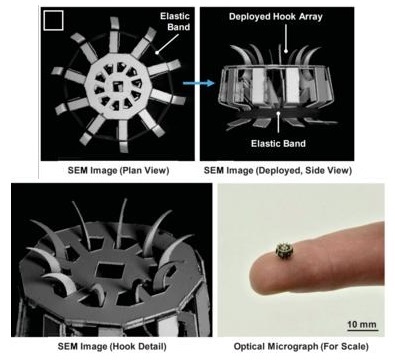Parasite-Inspired Medical Device Mimics Tapeworm Hooks for Soft Tissue Anchoring
|
By HospiMedica International staff writers Posted on 04 Dec 2024 |

Implantable and ingestible devices offer minimally invasive approaches for drug delivery, diagnostics, and monitoring previously hard-to-detect conditions. These devices often need mechanisms to attach to tissue in order to function effectively for prolonged periods at specific locations. As a result, enhancing mechanical adhesion to particular human tissue types has become an important area of research over the last two decades, with significant implications for diagnostics, therapeutics, and surgical device design. Attachment mechanisms can help medical devices target specific regions of the gastrointestinal (GI) tract or other soft tissues for tasks such as sensing, sample collection, and drug delivery. Inspired by the attachment structures found in parasites, researchers have now developed a millimeter-scale mechanism to anchor medical devices to soft tissues.
Scientists from Harvard John A. Paulson School of Engineering and Applied Science at Harvard University (SEAS, Cambridge, MA, USA) looked to parasites for inspiration in creating methods to affix small-scale medical devices to soft tissues, such as the gastrointestinal tract, for functions like sensing, sample collection, and extended drug release. Evolution has produced a variety of biomechanical structures for tissue attachment, and the researchers chose to model their design after the curved hook arrays used by certain species of tapeworms. The device, made of stainless steel and polyimide film, features curved hooks that are automatically deployed when external force is applied to the platform.
The device, presented in a paper published in the journal PNAS Nexus, was built using laminate manufacturing techniques, where layers are bonded with adhesive. It weighs just 44 mg and measures less than 5 mm in diameter when deployed, making it small enough to be integrated into ingestible capsule robots. According to scientists, this device can be used in various medical contexts. For example, it could serve as a platform to study how different parasite attachment structures impact tissue irritation and host pathology, paving the way for the development of medical devices that minimize patient morbidities. Future research may focus on further miniaturizing the device for easier integration into surgical tools, thereby reducing tissue damage during use.
Latest Surgical Techniques News
- New Transcatheter Valve Found Safe and Effective for Treating Aortic Regurgitation
- Minimally Invasive Valve Repair Reduces Hospitalizations in Severe Tricuspid Regurgitation Patients
- Tiny Robotic Tools Powered by Magnetic Fields to Enable Minimally Invasive Brain Surgery
- Magnetic Tweezers Make Robotic Surgery Safer and More Precise
- AI-Powered Surgical Planning Tool Improves Pre-Op Planning
- Novel Sensing System Restores Missing Sense of Touch in Minimally Invasive Surgery
- Headset-Based AR Navigation System Improves EVD Placement
- Higher Electrode Density Improves Epilepsy Surgery by Pinpointing Where Seizures Begin
- Open-Source Tool Optimizes Placement of Visual Brain Implants
- Easy-To-Apply Gel Could Prevent Formation of Post-Surgical Abdominal Adhesions
- Groundbreaking Leadless Pacemaker to Prevent Invasive Surgeries for Children
- Spectroscopy Technique Improves Surgery for Pediatric Epilepsy Patients
- Bioengineered Arteries Show Promise for Cardiovascular Surgery
- Online Tool Guides Surgical Decisions for Gallbladder Cancer
- Innovative Technology Enables Rapid Life-Saving Surgical Leak Detection
- First-Of-Its-Kind Bioresorbable Implant to Help Children with Rare Respiratory Disease
Channels
Critical Care
view channel
Mass Manufactured Nanoparticles to Deliver Cancer Drugs Directly to Tumors
Polymer-coated nanoparticles loaded with therapeutic drugs hold significant potential for treating cancers, including ovarian cancer. These particles can be precisely directed to tumors, delivering their... Read more
World’s Smallest Pacemaker Fits Inside Syringe Tip
After heart surgery, many patients require temporary pacemakers either to regulate the heart rate while waiting for a permanent pacemaker or to support normal heart rhythm during recovery.... Read more
AI-Powered, Internet-Connected Medical Devices to Revolutionize Healthcare, Finds Study
A new study suggests that artificial intelligence (AI)-powered, internet-connected medical devices have the potential to transform healthcare by enabling earlier detection of diseases, real-time patient... Read morePatient Care
view channel
Portable Biosensor Platform to Reduce Hospital-Acquired Infections
Approximately 4 million patients in the European Union acquire healthcare-associated infections (HAIs) or nosocomial infections each year, with around 37,000 deaths directly resulting from these infections,... Read moreFirst-Of-Its-Kind Portable Germicidal Light Technology Disinfects High-Touch Clinical Surfaces in Seconds
Reducing healthcare-acquired infections (HAIs) remains a pressing issue within global healthcare systems. In the United States alone, 1.7 million patients contract HAIs annually, leading to approximately... Read more
Surgical Capacity Optimization Solution Helps Hospitals Boost OR Utilization
An innovative solution has the capability to transform surgical capacity utilization by targeting the root cause of surgical block time inefficiencies. Fujitsu Limited’s (Tokyo, Japan) Surgical Capacity... Read more
Game-Changing Innovation in Surgical Instrument Sterilization Significantly Improves OR Throughput
A groundbreaking innovation enables hospitals to significantly improve instrument processing time and throughput in operating rooms (ORs) and sterile processing departments. Turbett Surgical, Inc.... Read moreHealth IT
view channel
Printable Molecule-Selective Nanoparticles Enable Mass Production of Wearable Biosensors
The future of medicine is likely to focus on the personalization of healthcare—understanding exactly what an individual requires and delivering the appropriate combination of nutrients, metabolites, and... Read more
Smartwatches Could Detect Congestive Heart Failure
Diagnosing congestive heart failure (CHF) typically requires expensive and time-consuming imaging techniques like echocardiography, also known as cardiac ultrasound. Previously, detecting CHF by analyzing... Read morePoint of Care
view channel
Handheld, Sound-Based Diagnostic System Delivers Bedside Blood Test Results in An Hour
Patients who go to a doctor for a blood test often have to contend with a needle and syringe, followed by a long wait—sometimes hours or even days—for lab results. Scientists have been working hard to... Read moreBusiness
view channel
Expanded Collaboration to Transform OR Technology Through AI and Automation
The expansion of an existing collaboration between three leading companies aims to develop artificial intelligence (AI)-driven solutions for smart operating rooms with sophisticated monitoring and automation.... Read more

















